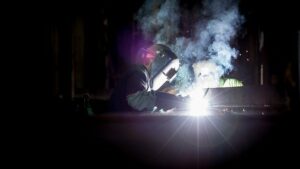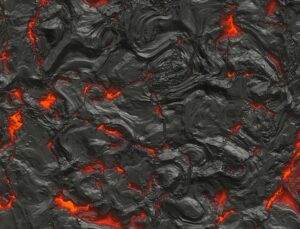Sound energy is produced when the system is perturbed producing the vibrational energy.
This vibrational energy is produced due to the back and forth motion of the molecules in the system, and this energy can be transferred to chemical energy. Let us discuss how we can convert sound energy to chemical energy.
How is sound energy converted to chemical energy?
Sound energy cannot be directly converted into chemical energy.
It has to either transform the energy into some other form of energy to produce the chemical energy or mechanical energy can be utilized to produce chemical energy.
Sound Energy to Chemical Energy Examples
The following is a list of examples that we shall discuss one by one as below:-
Drilling Oil
The oil is drilled from the Earth’s crust using mechanical and sound energy to obtain chemical energy.
The borehole is dug into the ground in the area where the crude oil is traced, and the oil is sucked upward through a pipe.
Car Batteries
The combustion of the fuel by the motion of the piston up and down charges the battery as the charged electrons pass to the battery. The sound is produced due to the friction of the piston which is reduced by using good fuel. Well, the combustion of the fuel supplies the chemical potential energy which is further converted into the kinetic energy of the car.
Rocket
The combustion of the fuel introduces the thrust on the surface of the earth to lift the body of the rocket upward against the gravitational force of the Earth.
This generates sound energy converting to chemical energy and turning to heat energy.
Atomic Blast
The spontaneous reaction of the radioactive elements in the air produces the noise which is converted into the chemical energy for the reaction to occur releasing a huge amount of energy into the air. This releases the charged neutrons in the air along with it depleting the amount of oxygen in the locality.
Firecracker
The crackling sound is produced as the small filling of iron or steel gets ignited. As the cover of the shell gets lifted up, the inflammable powder present within the shell burns to explode in the sky.
Grinding
While grinding the mixture, the friction between the mixture, the blades, and the mortar of the container produces sound energy which gives the chemical energy to break the components into the fine powder.
Mortar Pestle
Upon hitting the pestle on the mortar it generates sound energy. The vibrations produced by the frequent hitting of the pestle transmit the vibrations in the air by emitting the energy to the molecules in the air.

The pressure incident on the ingredients taken in the mortar turns into a fine powder, thus converting into chemical energy.
Boiling
When the temperature of the liquid reaches the boiling point, the sound of the bubbles floating upward and popping comes. The phase transition of the matter from liquid to vapor state takes place at this point. These vapors possess a huge amount of potential energy.
Centrifugation
This method is used to precipitate down the chemical component at the bottom of the tube. The sound energy is produced by the machine thus achieving chemical energy.
Fission
The fission of the radioactive element releases the highly energized particles freely. If the quantity of emission of the radiations is high then the sound energy is also produced. This is then transferred to some other element in the surroundings and causes the reaction to take place.
Welding
The excitation of the electrons in a cluster produces sound energy.

While the vibrations produced by hitting on the hot iron matter give the energy to the electron to excite thus releasing the chemical energy into radiant energy too.
Sparkling Stone
Upon hitting the two stones together, friction is produced across the surfaces of the stone. This frictional energy is converted into the heat energy which is supplied to the free electrons present in the stone that is hence excited due to the available energy and generates fire.
Water Turbine
The flowing water possesses mechanical energy and sound energy due to the abrasion and friction, which is converted into the electrical energy by using a turbine which converts the chemical potential energy of the water into the mechanical energy and further into the electrical energy.
Thundering
Thundering is caused due to the discharge of the electrons from the cloud, thus producing a loud noise. This then invites the rain showers along with the thunder converting the sound energy into chemical energy.
Volcanic Eruption
The volcanoes erupt releasing the sound energy due to erupting magma from the bottom of the Earth’s crust.

The magma carries a huge amount of minerals, elements, and debris which is a form of chemical energy.
Lighter
Upon pressing the lid of the lighter, it produces sound energy. This opens the lid of the container having butane liquid that when turns into a gaseous phase upon releasing the pressure and ignited as it comes to the oxygen in the air.
Concrete Mixture
The sound energy produced due to the motor is converted into chemical energy upon the rotations of the machine.
Frequently Asked Questions
What is meant by chemical energy?
The chemical energy is potential energy stored by the atoms.
The potential energy is stored by the formation of bonds with other chemical components which is given off when the amount of heat is supplied to break these bonds.
Is it possible to convert sound into electrical energy?
The sound wave imposes the pressure in the region due to the oscillation pattern of the molecules.
The sound waves are converted into electricity by using the piezoelectric material or transducer.
Also Read:
- How to find energy lost due to friction
- How to maximize radiant energy in photodynamic therapy for skin treatments
- How to calculate energy in a thermocouple
- How to maximize thermal energy recovery in thermal battery systems
- How to calculate the electrical energy generated by a photovoltaic solar panel
- How to calculate rest energy in special relativity
- Non mechanical energy examples
- Why is energy balance important in climate modeling
- How to find energy of a photon with frequency
- How to enhance thermal energy utilization in solar thermal power plants
Hi, I’m Akshita Mapari. I have done M.Sc. in Physics. I have worked on projects like Numerical modeling of winds and waves during cyclone, Physics of toys and mechanized thrill machines in amusement park based on Classical Mechanics. I have pursued a course on Arduino and have accomplished some mini projects on Arduino UNO. I always like to explore new zones in the field of science. I personally believe that learning is more enthusiastic when learnt with creativity. Apart from this, I like to read, travel, strumming on guitar, identifying rocks and strata, photography and playing chess.